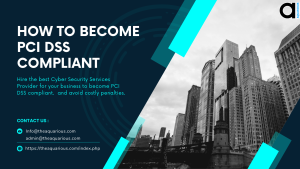How to Become PCI DSS Compliant

PCI DSS compliance is essential for businesses accepting payment card transactions. Failure to comply with the PCI DSS standards can result in hefty fines and damage a business’s reputation. This article will discuss how to become PCI DSS compliant, including the steps needed to meet the standard’s requirements.
An Overview of PCI DSS Compliance
PCI DSS refers to a compilation of security standards instituted by prominent credit card companies to guard against payment card fraud. Complying with PCI DSS is compulsory for all enterprises that accept payment card transactions.
PCI DSS compliance is a paramount prerequisite for businesses to abide by the most excellent practices for safeguarding cardholder data. Conformance with the standard aids in curbing data breaches, which may engender monetary losses and harm an enterprise’s standing.
Which Enterprises Require PCI DSS Compliance?
Any enterprise that accepts payment card transactions, whether debit or credit cards, necessitates compliance with PCI DSS. This pertains to both traditional and online vendors.
PCI DSS conformity obligations vary contingent upon the volume of payment card transactions that an enterprise processes annually. Businesses fall under four categories, depending on the number of yearly payment card transactions. Level 1 vendors transact more than six million payment card transactions annually, while Level 4 vendors.
The PCI DSS Compliance Process
The procedure of PCI DSS compliance entails a series of measures that commercial entities must undertake to ensure their adherence to the regulations. This approach includes evaluating the enterprise’s current security posture, identifying any vulnerabilities and adopting measures to mitigate those vulnerabilities.
Step-by-Step Guide to Becoming PCI DSS Compliant
Here is a step-by-step guide to becoming PCI DSS compliant:
Determine Your Merchant Level
The first step in becoming PCI DSS compliant is determining your merchant level. Your merchant level will determine the necessary level of compliance.
Complete the Self-Assessment Questionnaire (SAQ)
The next step is to complete the Self-Assessment Questionnaire (SAQ). The SAQ is a set of questions designed to assess your business’s security posture and identify any vulnerabilities that must be addressed.
Conduct a Vulnerability Scan
Once you have finished the Self-Assessment Questionnaire (SAQ), the subsequent action is to conduct a vulnerability scan. This scan is a process that recognizes any weaknesses in your systems that malevolent actors could exploit.
Fix Any Vulnerabilities Found in the Scan
After the vulnerability scan is complete, you must fix any identified vulnerabilities. This may involve updating software or hardware, changing configurations, or implementing new security controls.
Submit Compliance Reports
Finally, you must submit compliance reports to your payment processor or acquiring bank. The reports will demonstrate that you have met the requirements of the PCI DSS standard.
Maintaining PCI DSS Compliance
Ensuring PCI DSS compliance is not a solitary occurrence. Companies must persistently supervise and uphold their compliance posture to adhere to the standard. This may entail frequently carrying out vulnerability scans, introducing novel security controls, or revising current policies and procedures.
The Benefits of PCI DSS Compliance
Becoming PCI DSS compliant offers several benefits to businesses, including:
Improved security posture
PCI DSS compliance requires businesses to implement robust security controls to protect against data breaches, which helps to improve their overall security posture.
Reduced risk of data breaches
Compliance with the PCI DSS standard can help to reduce the risk of data breaches, which can result in financial losses and damage to a business’s reputation.
Increased customer trust
Customers are more likely to trust PCI DSS-compliant businesses because it demonstrates that the company is taking steps to protect its sensitive data.
Reduced liability
Compliance with the PCI DSS standard can reduce a business’s liability in the event of a data breach.
The Costs of PCI DSS Compliance
Maintaining PCI DSS compliance can be costly for businesses, especially those at higher merchant levels. The costs of compliance may include the following:
- Purchasing and installing new hardware and software
- Conducting regular vulnerability scans
- Implementing new security controls
- Hiring a Qualified Security Assessor (QSA) to conduct compliance audits
Common Challenges in Achieving PCI DSS Compliance
There are several common challenges that businesses may face when attempting to achieve PCI DSS compliance, including:
- Lack of resources: Maintaining PCI DSS compliance can be time-consuming and costly, and many businesses may not have the resources to devote to compliance efforts.
- Lack of expertise: PCI DSS compliance requires high technical knowledge, and businesses may need help finding qualified staff to implement and manage their security controls. You might want to hire professionals from a Cyber Security Services Provider to help you through this.
- Complex requirements: The PCI DSS standard includes many complex needs that can be difficult for businesses to understand and implement.
Tips for Achieving and Maintaining PCI DSS Compliance
Here are some tips for achieving and maintaining PCI DSS compliance:
- Understand the requirements: Familiarize yourself with the needs of the PCI DSS standard to ensure that you meet all of the necessary criteria.
- Conduct regular vulnerability scans: Regular vulnerability scans can help you to identify and remediate vulnerabilities before attackers can exploit them.
- Implement robust security controls: Implementing strong security controls, such as firewalls, encryption, and access controls, can help to protect against data breaches.
- Train employees: Educate your employees on the importance of PCI DSS compliance and provide training on following the necessary security procedures.
- Monitor and maintain compliance: Regularly monitor your compliance posture to ensure you remain compliant with the standard with the assistance of a cyber security services provider.
Conclusion
For businesses that handle payment card transactions, attaining PCI DSS compliance is indispensable. Although achieving and sustaining compliance may be challenging, safeguarding against data breaches and upholding customer trust is crucial. By adhering to the steps outlined in this article and applying best practices for security, businesses can accomplish and uphold PCI DSS compliance.
If you require assistance with reaching and maintaining PCI DSS compliance, Aquarious Technology is here to assist. Besides being a web development and design company, we are a Cyber Security Services Provider. Our team of cybersecurity specialists possesses extensive expertise in establishing security controls and ensuring compliance with industry standards, such as PCI DSS. We can comprehensively assess your organization’s security posture, detect vulnerabilities, and provide remediation recommendations. Additionally, we can aid in implementing novel security controls and policies and provide continuous monitoring and maintenance to ensure ongoing compliance. Contact us today to learn how we can assist you with your cybersecurity requirements.
-
14
+Category
-
98
+Post
Top Categories
Popular Posts
- The Power of Prototyping in Software Development
- Version Control Best Practices for App Development
- Understanding Visual Hierarchy: A Guide to Effective Design
- Crafting Intuitive Navigation: A Guide to Seamless User Experience
- Choose Your Best Cloud Provider
- Making the Leap: Transitioning from Manual to Automated Software Testing
- Using GitHub- Advantages and Disadvantages
- E-commerce Product Photography on a Budget
- Tech Innovation in Developing Countries
- Smart Cities: How Technology is Shaping the Urban Landscape
- Principles of Composition: Creating Visual Harmony with Composition
- Exploring Cross-Platform App Development
- Why Regular Website Updates Matter
- Navigating Effective Facebook Audience Targeting
- Implementing Ads for Game Monetization
- Designing User-Centric Mental Health Apps: Enhancing Well-being in the Digital Age
- NFTs and Collectibles: Creating NFT App Solutions for Collectors and Enthusiasts
- Successful Implementation of Enterprise Apps
- Maximizing Business Impact with EQ
- Proven SMO Ads Optimization Tips (2023)






